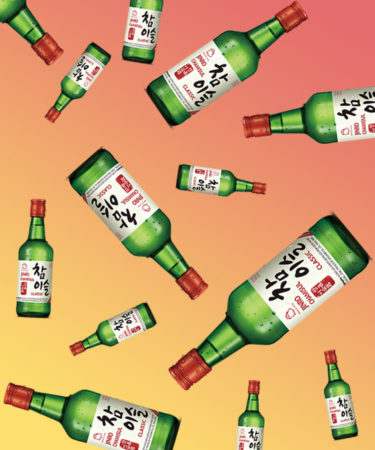Soju is the spirit of choice in South Korea, and no brand is more popular than Jinro. Launched in 1924, Jinro is the country’s best-selling soju brand — and the world’s top-selling spirit. Some even say Jinro is the cause of Korea’s well-documented, hard-drinking culture.
Parched for knowledge? Here are eight more things you should know about Jinro Soju.
Jinro Soju is the best-selling spirit brand in the world.
According to International Wine and Spirits Research (IWSR), which annually ranks the world’s largest spirits brands by volume, Jinro is the most popular alcoholic beverage on the planet. It sells more soju than the second- and third-place soju brands combined, and has held the top position since 2002.
You can shoot it, sip it, or sub it in cocktails.
Jinro Soju is a clear, neutral spirit akin to vodka, with about half the alcohol content. It is best served chilled and most often consumed straight and with food. It can also be mixed in cocktails as a substitute for vodka or gin. Jinro publishes cocktail recipes on its website, which range from the simple, like the Jinro Soju Sunrise (2 ounces Jinro Soju, 4 ounces pineapple juice), to the complicated, like the Jinro Summer Vay K (2 ounces Jinro Soju, ½ ounce sweetened condensed milk mixed with ½ ounce whole milk, ½ ounce passion fruit puree, ½ ounce fresh lime juice).
Jinro is soju, and so much more.
Jinro is best known for its soju, but it also produces other boozy beverages. Jinro Chamisul Classic Soju is the flagship label produced since 1924. Jinro Chamisul Fresh Soju is a slightly lower-ABV version filtered through charcoal made from Korean bamboo. Jinro 24, a 24-percent-ABV version of the spirit, is ideal for mixing in cocktails.
Jinro also has a flavored soju lineup, including Jinro Chamisul Grapefruit, Jinro Green Grape, and Jinro Plum. It produces a raspberry wine (Jinro Bok Bun Ja), a plum wine (Jinro Mae Hwa Soo), and a rice wine (Jinro Makguli). Another offering is its 3-percent-ABV, peach-flavored bubbly drink called Jinro TokTok Peach.
(There’s also a Jinro Light in the Philippines, according to Drink Manila.)
Jinro Soju is both social lubricant and staple of South Korean cuisine.
Soju is essential to any South Korean outing, so much so that Jinro’s small, 350-milliliter green bottle is synonymous with the soju category.
“A little green bottle, shot glasses around,” Max Soh, general manager and beverage director of New York’s Oiji, said in a 2015 interview. “When we go out to drink and have fun, soju’s always been there.”
It’s very possible Korean soap operas made it famous.
In K-Dramas, as in life, soju plays a prominent role. According to Daniel Gray, director of Seoul-based food tour company Delectable Travels, visitors often mimic soap opera characters’ drinking habits, “imitating art and doing it in real life,” Gray told VinePair in 2016.
American rappers and K-pop sensations are into Jinro.
South Korean singer of the 2012 monster hit “Gangnam Style,” Psy, became a Jinro Chamisul spokesperson in 2013. The partnership was aimed at the U.S. market, where celebrities and regulars had taken quite a shine to the satirical star. The song famously became the first video to reach 1 billion views on YouTube.
(FYI, Psy was no one-hit wonder. His 2014 absurdist ballad to drinking, Hangover, features Snoop Dogg — and plenty of soju.)
Jinro is an official partner of America’s pastime.
In 2013, Ryu Hyun Jin became the first South Korean baseball player to join the Los Angeles Dodgers, and Jinro became the first soju brand sold at Dodgers Stadium. In 2012, parent company HiteJinro partnered with the L.A. Dodgers to offer the stadium’s “first Korean and Asian beer.”
It’s traditionally untraditional.
Jinro Soju is made using rice, barley, and tapioca. Although this mix of starches is not unusual today, soju was originally made using only rice. Jinro and some other producers switched up their style when the Korean government banned rice for soju production. (Depending on the source, this ban was either instituted in 1965 during a rice blight, in the 1950s during the Korean War, or in 1910 when Japan annexed Korea.)
The ban was lifted in 1999. Soju drinkers had gotten used to their cheaper spirit, though, so soju producers began incorporating rice back into their recipes, but kept stand-in ingredients like sweet potato in, too. Now, a mix of starches is the new normal.
